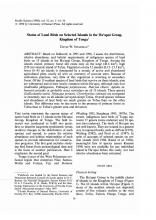Distribution, relative abundance, and habitat relationships of landbirds in the Vava'u group, Kingdom of Tonga / by David W. Steadman and Freifield, Holly B.

BRB
Available Online
Freifield, Holly B.
,
Steadman, David W.
1998
We assessed the distribution, relative abundance, and habitat preferences of the 12 indigenous, resident species of landbirds that survive in the Vavau Group, Kingdom of Tonga. We surveyed 16 islands, 10 of which are previously unmentioned in ornithological literature. The islands vary in land area (0.02-96 kn?), habitat composition, elevation (20- 215 m), and distance (O-lo.1 km) from the largest island of Uta Vavdu. We conducted point counts along transects on 14 of the islands, and placed each count location into one of five habitat categories. Of the 11 species of landbirds that are widespread and at least locally common, 7 (Purple-capped Fruit-Dove Ptilinopus porphyraceus, Pacific Pigeon Ducula pacijca, Common Barn-Owl Tyto alba, White-rumped Swiftlet Collocalia spodiopygia, Collared Kingfisher Halcyon chloris, Polynesian Tiiller Lalage maculosa, Polynesian Starling Aplonis tabuensis) certainly or probably occur on each of the 16 islands. One species (West Polynesian Ground-Dove Gallicolumba stairii) is extremely rare (one small population on one island). Three species that we did not record (Many-colored Fruit-Dove Ptilinopus perousii, Blue-crowned Lorikeet Vini australis, Fiji Shrikebill Clytorhynchus vitiensis) probably have been extirpated from Vavau. The species richness and relative abundance of landbirds on islands in Vavau are affected more by deforestation and other human activities than by island area, elevation, or isolation.

